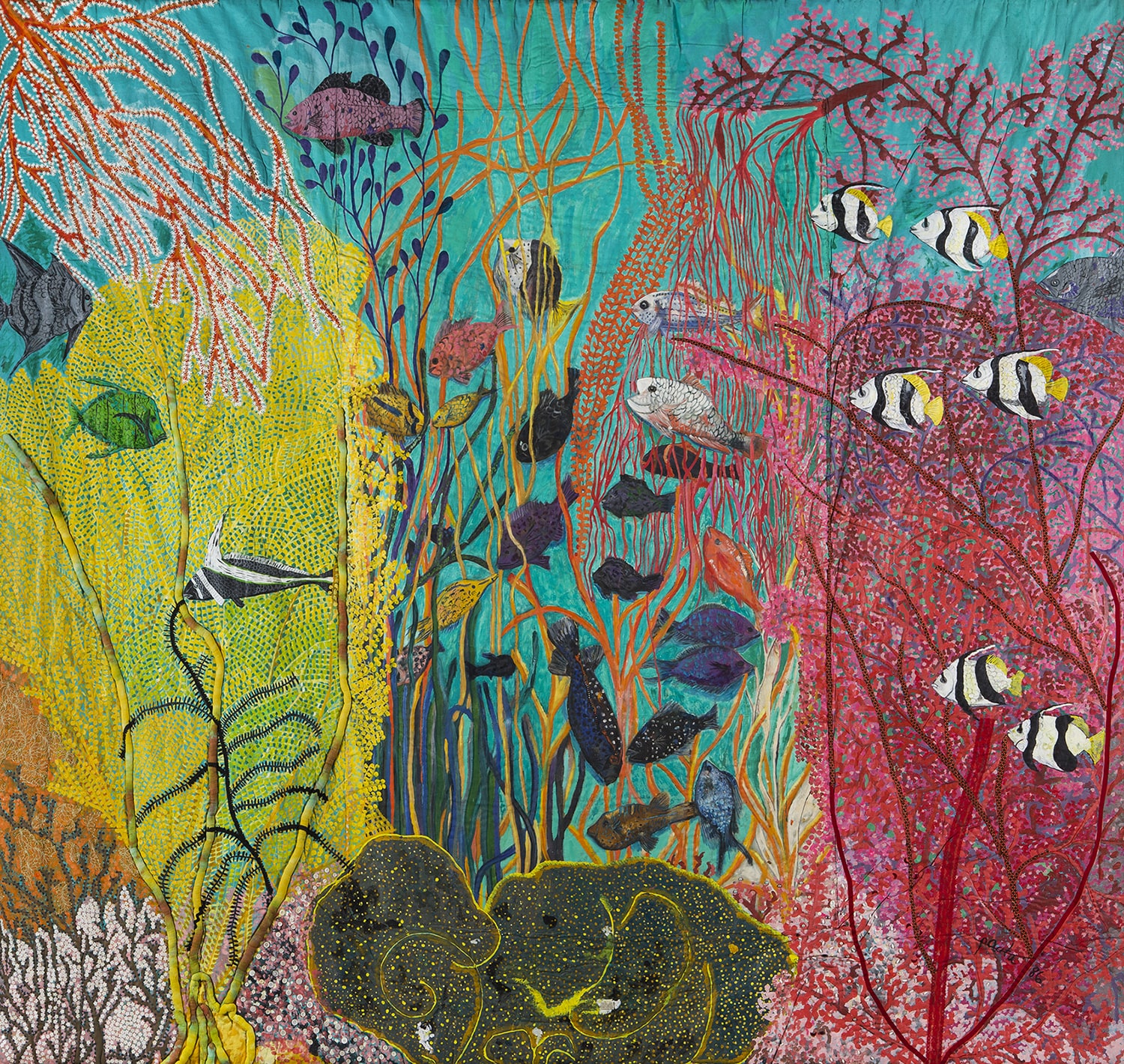Shows
Pacita Abad's “A Million Things To Say”


Walking through the glass doors of the Museum of Contemporary Art and Design (MCAD) in downtown Manila, one is immediately greeted by the domineering faces of Pacita Abad’s Bacongo VI (1986) and European Mask (1990)—each measuring two-and-a-half meters tall—composed of zig-zagging geometric shapes in orange, bright yellow, jade green and periwinkle blue. “A Million Things To Say”—curated by Abad’s nephew Pio, the Filipino contemporary artist, and MCAD director Joselina Cruz—is a highly focused exhibition of 24 trapuntos, textile collages and abstract assemblages from the prolific Philippine artist’s eclectic oeuvre, which comprises more than 4,500 works.
Dated from the 1980s to the early 2000s, the large-scale trapuntos on display appear to be paintings on flat canvases from afar, but a dizzying amount of detail is revealed on closer inspection. In Pacita Sailing (1987), a woman with black rick-rack trimming for hair, her face and body rendered in bold, embroidered lines in golds, oranges and pinks, can barely be distinguished from the twisting patterns of what appears to be a sailboat and the curling blue-green waves, similarly decorated with rick-rack ribbon. Parts of the canvas are stuffed with cotton to highlight the curved and straight lines, imbuing geometry with a sense of movement and rhythm.
Other paintings use found objects, such as buttons, lace, fragments of glass and mirror, batik textiles and even a flattened paint tube. As an avid scuba diver, Abad used her trapunto technique to particularly striking effect in her psychedelic underwater seascapes, such as Shallow Garden of Apo Reef (1986) and Dumaguete’s Underwater Garden (1987). Sequined fish dart between brightly hued corals and fluorescent weeds of vermillion, ruby and emerald, against an aquatic turquoise background, with glitter, gold embroidery and rhinestones used to emphasize the branches of a plant or the motion of water.

Abad's work is characterized by this granularity—a complex use of fragmentary and freestanding elements that come together to form an intuitive whole. In the show’s titular abstract painting, I Have One Million Things to Say (2002), dense, overlapping large dots are painted over stitched scraps of muslin cloth that appear to blend seamlessly with the rest of the canvas. The composition references dot paintings of Aboriginal art, which, like many indigenous art forms, preserve and pass on knowledge and folklore to subsequent generations. In One Million Things, the wealth of detail in Abad’s transformation of its layered surface seems to open up a multiplicity of narratives for us to unlock, too.
On the second floor was a timeline on the wall tracing Abad’s life and artistic career, as well as concurrent national and global political events. Born into a political family, Abad was expected to train as a lawyer before entering politics, although this path was cut short after getting in trouble due to her student activism against the Marcos regime, forcing her to move to the United States. The artist nonetheless continued to engage with politics in her work, as in a trapunto mounted on the wall by the timeline, titled LA Liberty (1992), in which the Statue of Liberty is reimagined as a woman of color wearing a patchwork robe adorned with buttons, pieces of mirror, and yarn. In the background, a rainbow of scarlet, turquoise, violet and many more dazzlingly bright hues radiates from the woman’s head to the edges of the canvas. Abad had visited New York’s Ellis Island to see the statue, and wondered why there were no stories celebrating the arrival of those coming from Asian, African and Latin American countries—her work recasts this icon of freedom and the American Dream to reflect the ethnic and racial diversity of the country’s immigrant population.

“A Million Things To Say” is an in-depth look at a segment of Abad’s ouevre that would become emblematic of the artist’s vibrant and multilayered style, reflecting precision and skill perfected over three decades. But the vivid subject matter and mutifarious cultural influences in Abad's work are derived in part from the adventurous life she led as the wife of an expatriate developmental economist, enabling her to travel, and see a variety of social, political and economic contexts up close. One wonders, then, about the many other works not included that would reveal the ways in which Abad reflexively engaged with her own identity in relation to others, particularly her topical series on the immigrant experience and refugees that she began in the 1970s,when she herself emigrated to the US. Perhaps if a wider spectrum of works were on show, one would know of the million more things Abad had to say.
Pacita Abad's “A Million Things To Say” is on view at the Museum of Contemporary Art and Design, Manila, until July 1, 2018.







